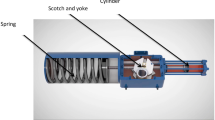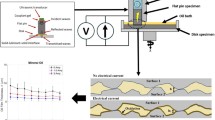Abstract
In an Electrostatic Rotating Bell atomizer, fluid is driven from a central orifice over the bell-cup’s surface toward its edge by the centrifugal force. After the fluid is ejected, it breaks-up into droplets a short distance from the bell-cup’s edge due to fluid instability and pressurized air forced normal to the fluid. Images of the bell-cup’s edge were captured as a 20 wt% aqueous glycerol solution was atomized using serrated and non-serrated bell-cups. It was observed that serrations at the bell-cup’s edge dictated the atomization mechanism of the fluid; their presence caused fluid to be ejected as thin ligaments, while their absence caused fluid to be ejected as sheets. The SMD (Sauter mean diameter) of each bell-cup was determined by capturing (and processing) images at a location 7 mm downstream of the bell-cup at several angular frequencies, ω. The SMD decreased as the angular frequency of the bell-cup was increased. The finite difference method was used to solve the Navier–Stokes equation for the velocity, U, and film thickness of a fluid flowing in channels created by serrations just prior to ejection. It was shown that the rate of change of the SMD based on the angular frequency was proportional to that of the film thickness. Furthermore, a stretching rate \(\dot{\gamma } = \omega^{2} R/\overline{U}\) was derived for serrated bell-cups based on the stretching of ejected ligaments and it was shown that the SMD \(\propto \dot{\gamma }^{ - 0.5}\), where R is the distance from the axis of rotation. The SMD of sprays generated using different bell-cups operating at various angular frequencies were equal when plotted against the stretching rate \(\dot{\gamma }\).
Graphic abstract

















Similar content being viewed by others
Abbreviations
- A :
-
Area [µm2]
- D :
-
Diameter [µm]
- E :
-
Eccentricity
- h :
-
Fluid film thickness [µm]
- l :
-
Arbitrary distance, \(= \overline{U}{\text{d}}\theta /\omega\) [m]
- ME:
-
Margin of error
- n :
-
Number of droplets
- N :
-
Sample size
- p :
-
Pressure [Pa]
- p̂ :
-
Estimate of proportion
- P :
-
Perimeter [µm]
- Q̇ :
-
Volumetric flow rate [cm3/min]
- r :
-
Radial cylindrical coordinate
- R :
-
Distance from the axis of rotation [m]
- R c :
-
Distance along cone wall [m]
- Ro:
-
Rossby number
- s :
-
Standard deviation
- SMD:
-
Sauter mean diameter [µm]
- t :
-
Time [s]
- t br :
-
Capillary time, \(= \sqrt {\rho h^{3} /\sigma }\) [s]
- t l :
-
Characteristic time, \(= \overline{U}/\omega^{2} R\) [s]
- u :
-
Velocity [m/s]
- \(\overline{U}\) :
-
Area-averaged velocity [m/s]
- v:
-
y-Direction velocity [m/s]
- w :
-
z-Direction velocity [m/s]
- x :
-
Channel length coordinate
- y :
-
Channel width coordinate
- z :
-
Channel height coordinate
- Z :
-
Confidence level
- α :
-
Cone half-angle [°]
- β :
-
Vertex angle of a triangle [°]
- \(\dot{\gamma }\) :
-
Stretching rate, \(= \omega^{2} R/\overline{U}\) [ms−1]
- δ:
-
Mesh size [µm]
- ζ:
-
Extrapolation factor
- θ :
-
Azimuthal cylindrical coordinate [rad]
- κ:
-
Vertical scaling coefficient of parabola [µm−1]
- ν :
-
Kinematic viscosity [m2/s]
- ρ :
-
Density [kg/m3]
- σ :
-
Surface tension [N/m]
- ω :
-
Angular frequency [kHz]
- 32:
-
Sauter mean diameter
- C :
-
Coriolis force
- c :
-
Cone
- d :
-
Droplet
- fl:
-
Flow
- i :
-
Cell indices in y-direction
- j :
-
Cell indices in z-direction
- n :
-
Number of droplets
- r :
-
Radial
- ω :
-
Centrifugal force
References
Bazant MZ (2016) Exact solutions and physical analogies for unidirectional flows. Phys Rev Fluids https://doi.org/10.1103/physrevfluids.1.024001
Bruin S (1969) Velocity distribution in a liquid film flowing over a rotating conical surface. Chem Eng Sci 24 11 1647 1654 https://doi.org/10.1016/0009-2509(69)87029-6
Charwat AF, Kelly RE, Gazley C (1972) The flow and stability of thin liquid films on a rotating disk. J Fluid Mech 53(2):227–255 https://doi.org/10.1017/S0022112072000138
Cochran WG (1977) Sampling techniques, 3rd edn.Wiley, New York
Corbeels PL, Senser DW, Lefebvre AH (1992) Atomization characteristics of a highspeed rotary-bell paint applicator Atomization Sprays 2(2):87–99. https://doi.org/10.1615/AtomizSpr.v2.i2.20
Di Domenico J, Henshaw P (2012) The effects of basecoat bell application parameters on elements of appearance for an automotive coatings process. J Coat Technol Res 9(6):675–686. https://doi.org/10.1007/s11998-012-9414-x
Dijk PE, Janse AMC, Kuipers JAM, Swaaij van WPM (2001) Hydrodynamics of liquid flow in a rotating cone Int. J Numer Meth Heat Fluid Flow 11(5):386–412. https://doi.org/10.1108/09615530110397334
Domnick J (2010) Effect of bell geometry in high-speed rotary bell atomization. In: Annual Conference on Liquid Atomization and Spray Systems, pp 1–7
Domnick J, Scheibe A, Ye Q (2005) The simulation of the electrostatic spray painting process with high-speed rotary bell atomizers. Part I: direct charging Part Syst Charact 22(2): 141–150. https://doi.org/10.1002/ppsc.200400968
Ellwood KRJ, Tardiff JL, Alaie SM (2014) A simplified analysis method for correlating rotary atomizer performance on droplet size and coating appearance. J Coat Technol Res 11(3): 303–309. https://doi.org/10.1007/s11998-013-9535-x
Hinze JO, Milborn H (1950) Atomization of liquids by means of a rotating cup. J Appl Mech 17(2): 145–153. https://doi.org/10.1115/1.4010093
Im K-S, Lai M-C, Liu Y, Sankagiri N, Loch T, Nivi H (2000) Visualization and measurement of automotive electrostatic rotary-bell paint spray transfer processes. J Fluids Eng 123(2): 237–245. https://doi.org/10.1115/1.1359210
Im* K, Lai M, Yoon S (2003) Spray characteristics on the electrostatic rotating bell applicator. KSME International Journal, 17(12): 2053–2065. https://doi.org/10.1007/BF02982446
Kuhnhenn M, Joensen TV, Reck M, Roisman IV, Tropea C (2018) Study of the internal flow in a rotary atomizer and its influence on the properties of the resulting spray. Int J Multiph Flow 100: 30–40. https://doi.org/10.1016/J.IJMULTIPHASEFLOW.2017.11.019
Makarytchev SV, Xue E, Langrish TAG, Prince RGH (1997) On modelling fluid flow over a rotating conical surface. Chem Eng Sci 52(6):1055–1057. https://doi.org/10.1016/S0009-2509(96)00473-3
Makarytchev SV, Langrish TAG, Prince RGH (1998) Structure and regimes of liquid film flow in spinning cone columns. Chem Eng Sci 53(8):1541–1550. https://doi.org/10.1016/S0009-2509(98)00011-6
Otsu N (1979) A threshold selection method from gray-level histograms. IEEE Trans Syst Man Cybern 9(1): 62–66. https://doi.org/10.1109/TSMC.1979.4310076
Ray R, Henshaw P (2018) Evaporation of clearcoat solvents from a rotary bell atomizer and its relationship with bell speed, flow rate, and electrostatic potential. J Coat Technol Res 15(1):41–49. https://doi.org/10.1007/s11998-017-9972-z
Roy P, Anand NK, Banerjee D (2013) Numerical simulation of flow and heat transfer in radially rotating microchannels. Microfluid Nanofluid 15(3):397–413. https://doi.org/10.1007/s10404-013-1159-z
Shevchuk I (2016) Modelling of Convective Heat and Mass Transfer in Rotating Flows, 1st edn. Springer International Publishing, Switzerland
Sidawi K, Moroz P, Chandra S (2021) On surface area coverage by an electrostatic rotating bell atomizer. J Coat Technol Res 18:649–663. https://doi.org/10.1007/s11998-020-00430-4
Stevenin C, Béreaux Y, Charmeau J-Y, Balcaen J (2015) Shaping air flow characteristics of a high-speed rotary-bell sprayer for automotive painting processes. J Fluids Eng https://doi.org/10.1115/1.4030703
Symons DD, Bizard AFM (2015) Measurement of fluid flow thickness within a rotating cone. J Fluids Eng https://doi.org/10.1115/1.4029728
Takamura K, Fischer H, Morrow NR (2012) Physical properties of aqueous glycerol solutions J Petrol Sci Eng 98–99 50 60 https://doi.org/10.1016/J.PETROL.2012.09.003
Walpole RE, Myers RH, Myers SL, Ye K (2016) Probability & statistics for engineers & scientists. Pearson
Acknowledgements
The authors thankfully acknowledge that funding for this project was provided by the Natural Sciences and Engineering Research Council (NSERC) of Canada and by Magna Exteriors. Experiments were carried out at the test facilities of Magna Exteriors. We are grateful for the assistance of Dr. Amirreza Amighi in carrying out droplet size measurements.
Author information
Authors and Affiliations
Corresponding author
Additional information
Publisher's Note
Springer Nature remains neutral with regard to jurisdictional claims in published maps and institutional affiliations.
Rights and permissions
About this article
Cite this article
Sidawi, K., Moroz, P. & Chandra, S. Bell-cup serrations and their effect on atomization in electrostatic rotating bell atomizers. Exp Fluids 62, 180 (2021). https://doi.org/10.1007/s00348-021-03266-9
Received:
Revised:
Accepted:
Published:
DOI: https://doi.org/10.1007/s00348-021-03266-9




